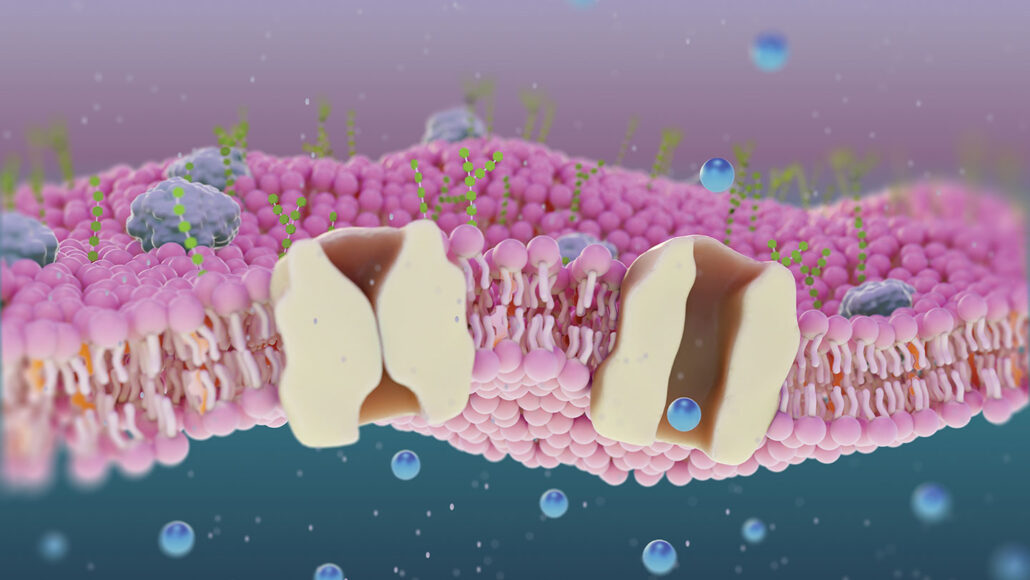Explainer: How cells use chemistry to make the electricity of life
It all starts with the migration of charged particles known as ions

The movement of electrically charged particles — ions (blue dots) — through a cell membrane (pink structure) can set up an electric current. Those ions must pass through channels (colored cream in this artist’s illustration). When channels are closed (left), ions can’t get through. When channels are open (right), ions flow freely.
Nanoclustering/Science Photo Library/Getty Images Plus
Every second, cells throughout your body send out small electrical signals. Tiny jolts control your heartbeat. In your brain, cells use electricity to release chemicals that make you feel happy or sad. In your muscles, they send signals that help you run, stand or reach for a glass of water.
But you’re not plugged into an electric outlet. And you’re not carrying around a battery. So where does that electricity come from? The cells themselves create these electric currents through the power of chemistry.
Cells are tiny bags of liquid chemicals, surrounded by an outer fatty jacket known as a membrane.
Those membranes separate chemicals inside the cell from what’s outside it. This separation allows cells to concentrate ions — atoms and molecules with an electric charge. Get enough of those ions together and the inside of the cell, too, will develop an electric charge.
The average animal cell is more negatively charged on the inside than on the outside. This difference in charge is called an electrochemical gradient. It represents the difference between the concentration and charge of particles on either side of the membrane.
This gradient is not stable.
Ions want to flow toward places where they are less concentrated. Negative ions in the negatively charged inside of a cell want to get out. Positive ions in the positively charged outside want to get in. So a cell’s membrane will trap ions inside the cell — but only for so long.
Cell membranes are dotted with channels. Think of them as gates that, under certain circumstances, open or shut. Some channels evolved as gates for charged particles — such as ions of sodium, potassium or calcium. When these channels open, ions flood from the side where they are more concentrated to the side where they are less concentrated.
This chemical flood changes the charge on either side of the membrane. And that change in charge then triggers more channels to open further down a cell’s membrane — sending the tiny electrical changes racing down toward the ends of the cell. This movement of charges is called an action potential.
Neurons offer a good example
Consider brain cells known as neurons. There are a lot more positively charged sodium ions outside these cells than inside. In contrast, these cells tend to concentrate more positive potassium ions inside their membrane, mixed with proteins. But the proteins have a negative charge. So the inside of the cell is much more negative than the outside.
When the charge in one part of a neuron’s membrane begins to change, sodium channels in the membrane will open. At once, sodium ions flood into the cell, bringing their positive charge. They rush in to try and balance both their chemical concentration in the cell and the cell’s electric charge.
This triggers other sodium channels around them to also open. More and more sodium ions move into the cell. As this happens, the negative charge inside the cell moves toward zero.
Channels for potassium ions now open. This allows these ions to leave the cell. Remember that these are positively charged. So when they leave, the charge inside a brain cell will drop back down to become negative again.
At the same time, a large protein in the membrane is constantly at work. Called a sodium-potassium pump, it brings some potassium ions back inside the cell and allows some sodium ions to go back outside the membrane again.
Over time, this restores the original electric charges along the membrane. That also prepares the whole process of ion transport to start again, as needed.
Do you have a science question? We can help!
Submit your question here, and we might answer it an upcoming issue of Science News Explores
Ready for action (potential)
Meanwhile, the electric signal triggered by the initial ion movement spreads along the membrane.
Neurons are cells with small bodies and long tails called axons. Once an action potential trips, it triggers sodium and then potassium channels to open up further and further down the axon. The result is a tiny jolt of electric charge that moves along the cell.
When that zap reaches the end of one neuron’s axon, it spreads out its finger-like ends, known as axon terminals. Each of these is very close to the membrane of another cell.
When the action potential reaches the axon terminals, it triggers the release of chemical neurotransmitters from the cell. Those chemicals act as messengers and float out to the next brain cell — triggering its ion channels to open.
This whole process repeats at that second neuron. It, in turn, quickly moves on to signal the next, neighboring neuron.
Such tiny electrical signals underlie our senses — how we smell, hear, touch, taste and move. They also underlie every thought and emotion.
Other cells in the body have electrical activity too. In the heart, cells move calcium ions to help control your heartbeat. Electrical signals also tell cells in your muscles to shorten — making the tissue contract.
As in the brain, all of these cells operate with the help of ion migrations, which trigger tiny sparks of electricity.







